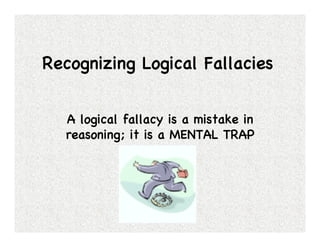
9 Logical Fallacies(Slideshare)
- 1. Recognizing Logical Fallacies ! A logical fallacy is a mistake in reasoning; it is a MENTAL TRAP!
- 2. Looking at the Negative Space • We can learn much about logic by studying that which is not logical— examples of where logic breaks down, logical fallacies.
- 3. 1. Over-generalization ! • Drawing too wide a conclusion from the given facts ! • Example: ! – All kids cause trouble.! – Timmy is a kid. ! – Therefore, Timmy causes trouble.! Fix this by recognizing qualifiers (many, few, some, all, etc.)
- 4. 2. Arguing in Circles • Def: Supporting an opinion not with evidence but with the same opinion, slightly disguised (restating the argument in different words). Using the word you’re defining in the definition is a classic example.! • Example:! – Education is important for kids, so they should get an education.! – Everybody likes ice cream because it is liked by all.! – “Belligerently” means in a belligerent way.! Fix it by making sure you are giving support, not just repeating the idea. Never use the word you’re defining in the definition.!
- 5. 3. Black & White Thinking • Def. An opinion that claims there are only two alternatives (when there might be more) • Examples: – You’re either for it or against it. – Are you a jock or a nerd? Fix this by remembering that the world is a complicated place and that on most issues there are many alternatives.
- 6. 4. Red Herring • Def. Presenting an irrelevant topic to divert attention away from the original issue. • Also known as Ad hominem: getting personal as you discredit someone. • Examples: – What do you know? You’re just a kid. – I got an F. Mr. X hates me. Fix this by staying focused on the topic; watch out for those who don’t.
- 7. 5. Loaded Questions and Statements • Def. A question or a statement that conceals an opinion or assumption. • Examples: – Do you still beat your dog? – You don’t think that, do you? – All intelligent people agree that … Fix this by listening carefully and separating fact from opinion.
- 8. 6. Statistical Fallacies False Authority • Def. People usually believe in numbers and experts without questioning them. Here statistics are used to misrepresent rather than describe. • Examples: – 3 out of 4 dentists prefer Crest. (Did Crest pick the dentists?) – I surveyed 100 people and they all agreed with me. (I chose my friends). – Dr. X says this is the fastest and safest way to lose weight. (Did he/ she get paid? Where do they practice?) Fix this by analyzing the evidence. Where did the support come from? Is there self interest involved? Did you get the whole picture?
- 9. 7. Faulty Causal Relationship (also called Post Hoc) • Def. To excuse an action or belief by making it sound sensible. Often this assumes that anything that came before an event caused it to happen. • Example: – I stole the towel from the hotel. They expect people to take them. – Eating 5 energy bars and drinking 2 Cokes helps me get better grades. I did this and got an A on my history test. Fix this by examining the relationship between ideas. Make sure the facts precede the theory and the reasons precede and cause the belief.
- 10. 8. Misleading Comparison • Def. Mistakenly believing that two situations or people can be compared. • Examples: – Jill looks good in red. I’ll buy red pants, too. – Forcing students to read books is like herding cattle to slaughter. – You gave him extra time on the test, so I should get extra time too. – Saddam Hussien is Hitler. Fix this by remembering that every person and situation has different circumstances.
- 11. 9. Bandwagon • Def. Lots of people do this, so you should, too. • Examples: – Adults are smoking, so it is ok to do so. – The American people do not stand for . . . Fix this by making decisions based on facts, not popularity.